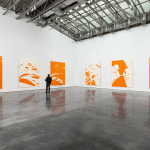
Contributed by Jenny Zoe Casey / The title of the group exhibition “1,000 Year Current,” on view at Field of Play Gallery in Gowanus, refers to the time it takes for a particle of water to circumnavigate the earth. Curated by gallery director Matt Logsdon, the show encompasses a generous range of linked subjects, from the sea’s primal mysteries to its vulnerability to climate change.

Ketta Ioannidou‘s Mesmerism II is the largest piece in the show. Long, slightly blurred strokes cross the canvas in blues and greens, implicitly stretching beyond its confines to suggest vastness. In her paint handling, Ioannidou mimics the interaction of light and water and sets a tone of reflection and consideration of the unseen.
Picking up on the delicate sense of movement in Mesemerism II, Lauren Skelly Bailey’s The Bends is a stoneware sculpture composed of bulbous tubes fused to a footed, rounded base. Glazed in mid-blues and toned-down aquas, they resemble the gelatinous soft parts of sea creatures as they resist and yield to the pressure of seawater. In another sculpture by Bailey, Caught in the Wave, folds and layers of clay suggest the sedimentation of hard-shelled sea creatures. The piece has undergone multiple re-firings, nodding to the inherent capacity of the sea and its creatures for renewal following breakdown.

Christopher Lin’s installation In Zuru zuru (Drifting) also embraces nature’s capacity for regeneration. Seated on an elegant wooden stand is a working aquarium containing eleven stoppered glass bottles that float, drifting gently into shifting configurations. The piece is visually pleasing: the bottle groupings establish rhythms, reflections sparkle, and the diagonally-massed sand activates the window. Each bottle is a tiny terrarium, containing elements that together maintain balance and build life from life: soil and mosses, lichens, springtails, dwarf isopods, activated charcoal. A single, smaller bottle rests in the deepest part of the vessel, a sunken biosphere. The bottles read symbolically as arks – harbingers of a future that may not include warm-blooded mammals.

Ioannidou’s approach to the sea is perceptual, Bailey explores saltwater ecologies through metaphor, and Lin takes a more scientific approach. Elizabeth Insogna, who has four ceramic pieces in the show, responds to the ocean on a spiritual level, as a source of mystery. Three of her pieces are wall reliefs, made up of linear forms glazed in verdigris, cobalt, and lavender. Markings that appear worn and roughened textures impart great age, and the shapes suggest talismans or sigils. Her fourth piece, a sculpture elaborately titled Eyes shining with stars fiery – stripped the trees with wind down the mountain; love, approximates the shape of a tree in wind. In conversation with Bailey’s The Bends owing to its fluidity, the surface flickers and catches the light. Slight indentations enhance a sensation of movement while iridescent glazes bring to mind pearls and the alchemy of transformation.


Wesley Ware’s Untitled has a circular form. Holes have been cut into paper imbued with watercolor in the saturated hues of a woodland pool on a summer day. Each layer is physically separated by an inch or so, creating literal depth. Nestled into some of the spaces effected by the cuts and layering are tiny plastic ducks. This affords the piece a warm, playful vibe, tempered by the show’s sobering theme. Rotating oceanic gyres trap debris, and toys dumped in container ship accidents travel the 1,000 year current, marring the beauty of distant shores and, beyond that, imperiling the sustainability of the earth at least as we know it.
“1,000 Year Current,” Field of Play, 56 2nd Avenue, Suite 21, Brooklyn, NY. Through November 11, 2023. Artists: Elizabeth Insogna, Ketta Ioannidou, Christopher Lin, Lauren Skelly Bailey, Wesley Ware. Curator: Matt Logsdon.
About the author: Jenny Zoe Casey is a Chicago-based painter and art writer.






















